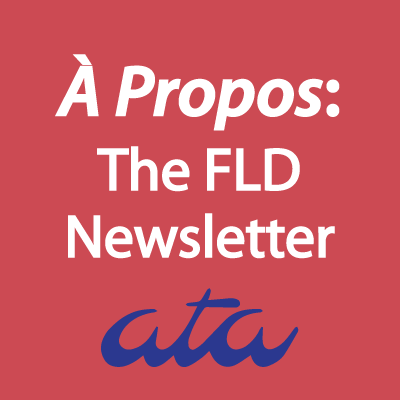 By Meghan McCallum
By Meghan McCallum
Earlier this year, I was delighted to receive the news that I had passed the ATA French to English certification exam. I now have an official Certified Translator seal and the designation of “ATA-certified French to English translator” in my credentials. And, of course, I’m looking forward to sporting the “Certified” ribbon on my badge at ATA59 in October!
ATA certification has long been a hot topic among translators—even more so in recent years, as it has undergone significant changes in both the technology used and the content of the exam itself. And the certification program has additional changes ahead, such as an increased exam price of $525 coming in 2019 as well as tentative “decoupling”—meaning that non-ATA members would be able to take the exam starting in 2020.
My story with the ATA exam starts with a failed attempt back in the handwritten days, and success years later on the computerized exam. I’d like to share my own personal experience with the ATA certification exam for translators who are considering becoming certified, those who might be wondering what the computerized exam is like, or anyone else generally interested in the topic.
Why Get ATA Certified?
ATA certification had been on my professional bucket list ever since graduate school. As a student in a master’s program for translation, I learned early on that ATA certification is a great way to distinguish yourself not only as a serious professional, but also as someone who can be trusted to produce quality translations in a specific language pair. From that time, I knew that ATA certification was something I wanted to strive for in my career.
My general career plan for after graduate school was to work at an agency for a few years to learn the daily ins and outs of the business, before eventually moving on to freelancing. I knew that once I was working as a freelance translator, having ATA certification would allow me to stand out from the crowd.
First Things First
Before even considering taking the exam, however, there were a few other items I wanted to take care of. First on the list was becoming an ATA member and taking advantage of the organization’s many resources. I became a student member and started reading The Chronicle, getting involved in volunteer opportunities, and attending conferences. I learned more about the exam process by speaking with fellow members, reading articles and blog posts about certification, and attending an exam preparation session at a conference.
I graduated from my master’s program and started a job at a translation agency. I was enjoying getting to know the agency perspective, learning as much as I could to prepare for my future in freelance translation. When I saw that there was a certification exam coming up in my city, I registered and started preparing.
The Pre-Keyboard Era: Taking the Handwritten Exam
My biggest hesitation with the exam was that it was handwritten, and no electronic resources were allowed. I had rarely translated by hand in my graduate work, and I certainly didn’t have any handwritten tasks at my agency job. Quite the contrary: my days were spent on an e-mail platform, a web-based project management application, and a CAT tool. Writing a three-hour exam by hand did not seem representative of what was actually practiced by professional translators.
However, the exam was only offered in the handwritten format at that time, so I decided to give it a shot. I prepared using some texts recommended by a professor from my graduate program. I had heard of the practice tests offered by ATA, but decided to practice on my own without taking a practice test. I knew this was a risk, but I felt that I might as well take it and see how my skills measured up at the time.
Exam day eventually arrived. We all came into the room with our arms (or suitcases!) loaded down with dictionaries, notepaper, and pencils. The three hours went by in a flash. I remember scrambling to get my sentences in just the right order, flipping through dictionaries for terms and writing and re-writing passages as my hand started to cramp. In the end, I did not have a good feeling about it. Not only was I unaccustomed to the handwritten format and the exclusion of online resources, but I realized that I just wasn’t in the habit of translating on a full-time basis as I probably should have been to pass the exam.
I knew it could take up to a few months to receive my results, so I tried to push it to the back of my mind and wait to see what came in the mail. I still vividly remember my heart sinking as I opened the thin envelope from ATA headquarters and read the dreaded opening line: “Dear Colleague: I regret to inform you that your certification examination from French into English did not meet the standards for ATA certification.” I wasn’t completely surprised, as the exam hadn’t gone as well as I’d hoped, but of course I was still disappointed.
For me, this was confirmation that I still had much room for improvement, and I needed to practice translating on a regular basis before taking the exam again. And although I knew my translation skills weren’t quite where they needed to be yet, I also knew that my exam result was partially due to the format. I still felt strongly that the handwritten format was unrealistic, and promised myself that I wouldn’t reattempt the exam until it was in an electronic format.
Technology for the Win
Fortunately, the exam began shifting toward a computerized format in the years that followed. In the meantime, I spent a few more years working at the translation agency and eventually moved on to start my own business as a freelance translator. After I’d been freelancing for a little over two years, a promising opportunity came up. A computerized exam was going to be offered in my state, and I decided I was ready to try it again.
Leading up to the exam, I spent a lot of time translating in my daily work and reviewed all the exam information provided by ATA headquarters very carefully. The ATA-provided guidelines were extremely useful, outlining what exactly the exam tests for, online resources permitted, items to bring besides a computer, procedures required for saving the exam content to an external device for submission, what specific programs can be used to type the translation, and much more.
Again, I forewent the practice tests and took the risk of practicing on my own. I did feel much more prepared this time, however, as I had been keeping very busy with translation work and felt I had essentially been “practicing” full-time. Plus, I felt confident that I would perform much better in a format that more closely resembled my daily work; i.e., working on a computer instead of using pencil and paper.
The exam content had also changed since my first attempt several years earlier: instead of choosing between specialized texts categorized as medical/technical/scientific and legal/commercial/financial, exam candidates now select two of three general passages. This change eliminated the risk of me having to translate a passage from an area I don’t work in, such as legal or technical.
On the big day, I opened the exam packet and took out a detailed set of instructions. I read these instructions very carefully before starting, and consulted them several times throughout the exam to be sure I followed them. The instructions provided a specific use and audience for each passage so I could translate with this in mind. I also allowed myself a certain amount of time at the beginning of the exam to read through my three available passages and select the two I would translate. Before starting to translate, I made a list of key terms in the passages to ensure that I chose my English terms carefully and used them consistently throughout my translation.
Working with a computer and online resources indeed proved to be a better environment for me. I much preferred having the ability to type and make changes very quickly, as well as consult and compare a variety of resources. I felt much better during the actual exam, though I still worked very carefully.
Although typing saves a lot of time compared to writing a translation by hand, I still used the entire three hours to work on my exam. I reviewed each translated passage after finishing, and reviewed both translations again at the end when I had some time left. When reviewing, I went through a personal QA checklist, inspecting elements such as capitalization, numbers, punctuation, repeated words, etc. I also made sure to save my work regularly and prepared to load it onto the USB drive when the exam time was drawing to a close.
Although I wasn’t 100% sure what my result would be, I felt much better leaving the exam room this time around. Not only had I worked in an environment that was much closer to my actual day-to-day work, but I also had much more full-time translation experience under my belt.
Enjoying the CT Designation
This time, the envelope I received in the mail from ATA headquarters made me much happier—I passed! The best part of this moment was the feeling of accomplishing something that had been a personal career goal for many years.
Besides the personal accomplishment, I have also enjoyed immediate results in my work as a freelance translator. I made a point of updating my online profiles and website right away, and notified colleagues and clients as well. I have noticed an increase in messages from my website, and I’m now able to contact potential clients that only work with ATA-certified translators.
Another benefit to being an ATA-certified translator is the official seal. I like to use the seal in my e-mail signature as well as on official documents. I had a stamp made with the seal image, and I use it when I provide notarized statements of accuracy for personal translations.
Finally, as I mentioned before, I’m very much looking forward to having the “Certified” ribbon on my conference badge as well. I’m proud to join the ranks of ATA-certified translators and I look forward to carrying the designation as I continue my career for years to come.
Meghan McCallum is an ATA-certified French>English freelance translator specializing in corporate communications, human resources, marketing and financial documents. She holds an MA in language, literature, and translation (concentration in French>English translation) from the University of Wisconsin–Milwaukee. Before going freelance, she worked in-house for several years at a global language services provider, serving as a project manager and quality manager. She is the coordinator of ATA’s School Outreach Program. Website: www.fr-en.com.

